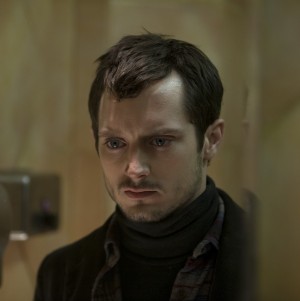‘Maniac:’ A Visceral Trip through the Macabre
They say it’s often times the quiet ones. The ones you would never expect. The ones that seem harmless. Maniac’s Frank Zito (Elijah Wood) is one of “those.” The lone owner of a mannequin restoration shop, Frank is a lumpish man who blends into even the most transparent of crowds — attracting attention only when his piercing stares linger a bit too long. Using his own insignificance to his advantage, Frank is also an unhinged man who stalks, murders and scalps women in the hopes that their luscious locks will add a touch of life to his plastic companions and a little clarity to his own insanity.
With French director Franck Khalfoun at the helm, Maniac is a remake of the 1980s horror film of the same name, and to say that it is graphic would be a grave understatement. Driven by Frank’s insatiable thirst for harming women as way of dealing with his unstable mind, Maniac, which received positive remarks after its premiere at the Cannes Film Festival in May, is nothing less than a grotesque display of sadistic violence that will send shivers down your spine and leave a lump in your throat. A chilling tale that has been likened to a modern-day Jack the Ripper. Yet, even with excessive images of women being maimed and murdered, the most horrifying facet of this film is how it implicates the audience in Frank’s atrocities.
In unique fashion, Khalfoun makes the inspired choice to shoot his film, not from a traditional omnipresent viewpoint, but through those wandering eyes of Frank’s. Acting as a conduit for the audience into Frank’s psyche, Khalfoun creates a first-person scope that becomes essential into understanding the internal struggle within the psychopath. What results is a visceral and immersive look at the drive and motivation of a serial killer that is both insurmountably shocking and occasionally fascinating.
With this tunneled vision, the audience is unwillingly (or willing, depending on how you look at our society’s fascination with murder) living vicariously through Frank’s predatory instincts and, therefore, complicit in his crimes. As he lurks in the shadows, we are lurking alongside of him, zeroing in on his next prey. We hear his heavy breaths and comments to himself, as he waits to pounce on his unassuming victim. This invasive take raises the inevitable question of accountability and guilt that some viewers will find washing over them. If nothing else, it is something many have never experienced in the theater before, and won’t likely soon forget.
While the first-person point of view can, at times, feel like another found-footage addition to the horror genre with its shaky-cam tendencies (previous entries including the Paranormal Activity films), it is ultimately effective because Khalfoun understands that our truest perception of the world comes from how we see it for ourselves. He uses this perspective as way of illustrating Frank’s crumbling mental state — manipulating the shots to indicate his frequent migraines (depicted by blurring the edges of the shot) and the frantic nature of his rampant paranoia. This POV is only escaped when Frank is seen in mirrored reflections or photos, or when he succumbs to almost existential out-of-body experiences in the heat of his brutal killings or in his one true moment of happiness. As he unravels, we are a caged audience caught behind Frank’s eyes, compelled to take in his warped view of the world.
Just as daunting as Khalfoun’s duty of capturing our attention for this trip down sociopathic lane is Wood’s job of bringing Frank to life. Even though he is mainly heard off-screen, Wood’s feeble build, mild manner and understated tone easily invoke the subtle danger that makes Frank such a menacing figure. Even his sunken eyes act as an imposing and haunting abyss of ambiguity. But as a young man scarred from a childhood of witnessing his mother’s addictions to sex and drugs, Frank is more than his sickness and Wood knowingly builds the complex layers needed to convey Frank’s uncertainty with the world and himself. As much as he is a crazed killer, he is also a stunted man, whose impotence (thanks to his mother’s extracurricular activities) manifests in terrifying hallucinations that his body is becoming a mannequin itself. There is sympathy to him, though it is undoubtedly lost when he is placing the scalps of his victims on mannequins in order to make his only friends come to life. But at the same time, he is fighting his own mind’s attempt at dehumanizing himself every step of the way.
Ultimately, Maniac’s greatest achievement is its voyeuristic core, holding us captive as everyday people, people like us, are watched, followed and killed for no other reason than the instability of one of their fellow man. It’s a disturbing film that relies on the restraint of its artsy approach to keep it from spiraling into a gratuitous thriller with a scalp fetish. Thankfully, with Khalfoun’s originality and Wood’s apt performance, Maniac frequently cuts with the skilled precision of a scalpel and the fervor of a man losing his mind.
Rating: 3 out of 4 stars
Trailer Courtesy of IFC Films.
“Maniac” will be available on demand as well as showcasing in theatres on June 21, 2013. For more information, please visit http://www.ifcfilms.com/films/maniac.
Featured image: Elijah Wood looks at his reflection in the mirror in the film “Maniac.” Photo Credit: © La Petite Reine/Daniel McFadden.

